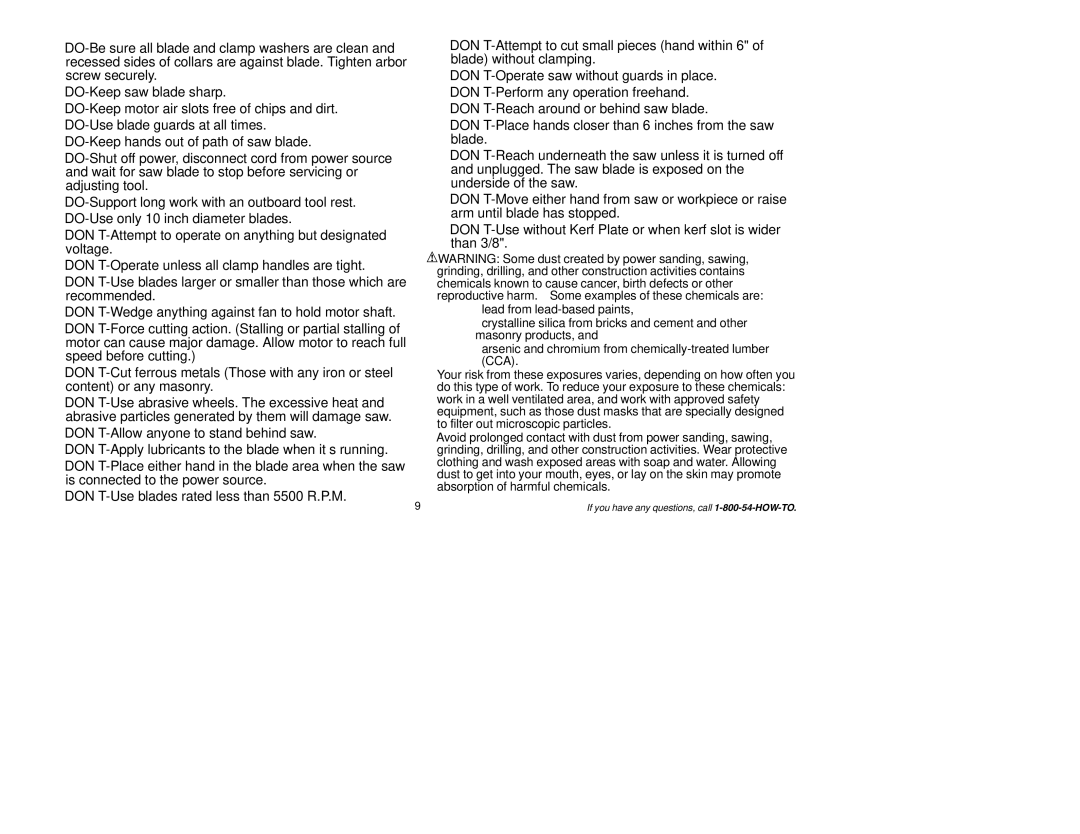•DO-Be sure all blade and clamp washers are clean and recessed sides of collars are against blade. Tighten arbor screw securely.
•DO-Keep saw blade sharp.
•DO-Keep motor air slots free of chips and dirt.
•DO-Use blade guards at all times.
•DO-Keep hands out of path of saw blade.
•DO-Shut off power, disconnect cord from power source and wait for saw blade to stop before servicing or adjusting tool.
•DO-Support long work with an outboard tool rest.
•DO-Use only 10 inch diameter blades.
•DON’T-Attempt to operate on anything but designated voltage.
•DON’T-Operate unless all clamp handles are tight.
•DON’T-Use blades larger or smaller than those which are recommended.
•DON’T-Wedge anything against fan to hold motor shaft.
•DON’T-Force cutting action. (Stalling or partial stalling of motor can cause major damage. Allow motor to reach full speed before cutting.)
•DON’T-Cut ferrous metals (Those with any iron or steel content) or any masonry.
•DON’T-Use abrasive wheels. The excessive heat and abrasive particles generated by them will damage saw.
•DON’T-Allow anyone to stand behind saw.
•DON’T-Apply lubricants to the blade when it’s running.
•DON’T-Place either hand in the blade area when the saw is connected to the power source.
•DON’T-Use blades rated less than 5500 R.P.M.
•DON’T-Attempt to cut small pieces (hand within 6" of blade) without clamping.
•DON’T-Operate saw without guards in place.
•DON’T-Perform any operation freehand.
•DON’T-Reach around or behind saw blade.
•DON’T-Place hands closer than 6 inches from the saw blade.
•DON’T-Reach underneath the saw unless it is turned off and unplugged. The saw blade is exposed on the underside of the saw.
•DON’T-Move either hand from saw or workpiece or raise arm until blade has stopped.
•DON’T-Use without Kerf Plate or when kerf slot is wider than 3/8".
 WARNING: Some dust created by power sanding, sawing, grinding, drilling, and other construction activities contains chemicals known to cause cancer, birth defects or other reproductive harm. Some examples of these chemicals are:
WARNING: Some dust created by power sanding, sawing, grinding, drilling, and other construction activities contains chemicals known to cause cancer, birth defects or other reproductive harm. Some examples of these chemicals are:
•lead from lead-based paints,
•crystalline silica from bricks and cement and other masonry products, and
•arsenic and chromium from chemically-treated lumber (CCA).
Your risk from these exposures varies, depending on how often you do this type of work. To reduce your exposure to these chemicals: work in a well ventilated area, and work with approved safety equipment, such as those dust masks that are specially designed to filter out microscopic particles.
•Avoid prolonged contact with dust from power sanding, sawing, grinding, drilling, and other construction activities. Wear protective clothing and wash exposed areas with soap and water. Allowing dust to get into your mouth, eyes, or lay on the skin may promote absorption of harmful chemicals.
9 | If you have any questions, call 1-800-54-HOW-TO. |
![]() WARNING: Some dust created by power sanding, sawing, grinding, drilling, and other construction activities contains chemicals known to cause cancer, birth defects or other reproductive harm. Some examples of these chemicals are:
WARNING: Some dust created by power sanding, sawing, grinding, drilling, and other construction activities contains chemicals known to cause cancer, birth defects or other reproductive harm. Some examples of these chemicals are: